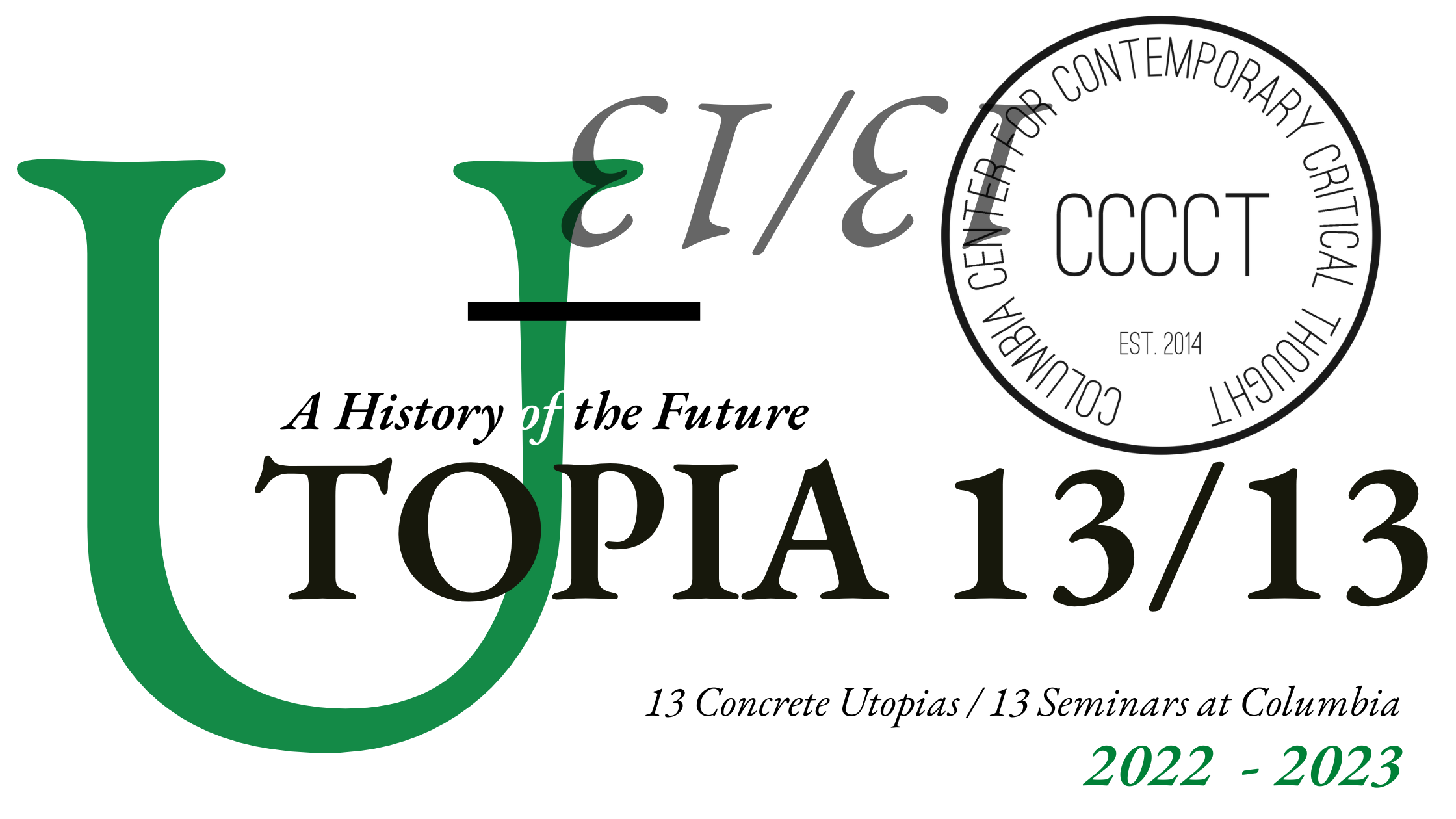By Bernard E. Harcourt
Our inaugural seminar with Étienne Balibar at Utopia 1/13 provided theoretical markers for an updated concept of “concrete utopias.” Four in particular:
- Partiality: Concrete utopias do not need to be as systematic and totalizing as earlier nineteenth- or twentieth-century conceptions of utopia. Rather than fully integrated systems, concrete utopias for the twenty-first century can be more partial, targeted, swift. They need to be put into action, and that means accepting miscalculations. They need not be elaborated at a world historical level. They do not need an eschatological dimension. They need to be punctual engagements in the present—the here and now—and can avoid the totalizing schemes.
- Distributional: Concrete utopias need to be visible and operate on what we can see. Balibar wrote about focusing less on deep causes and more on consequences—on distributional consequences. This resonates with a move away from the intricacies of systems theories toward more detectible analyses of relations of power. We need to focus today, Balibar argued, on “questions of war and peace, armaments, ways of life and use of resources, modes of interaction with the digital equipment…”[1] The idea is to highlight a different level of abstraction because, in Balibar’s words, “the chances to create alternatives do not reside at the abstract level of putting an end to the capitalist mode of production.”[2]
- Heterogeneity: We discussed at length Michel Foucault’s essay “Of Other Spaces: Utopias and Heterotopias” (1967/1984) and the concept of heterotopias. The term heterotopia is somewhat fraught because, at least for Foucault, it originally includes clearly dystopic spaces, such as the prison, the asylum, and the boarding school. But it carries with it an essential element of heterogeneity. This is the idea that we need to embrace different, heterodox concrete utopias and not seek just one; and, as Ann Stoler and Kendall Thomas suggested, we need to think about these heterogenous concrete utopias as action, as a verb, rather than as a noun. In order to keep the “u” of utopia but add the “hetero” of heterotopia (without keeping the “hetero” of heteropatriarchy), I will for the time being propose the term “uterotopia” (which interestingly gestures to the womb and critical genealogy, where we left off last year’s seminars at Revolution 13/13).
- Fallibility: Concrete utopias today may prove unsatisfactory tomorrow. They may become a burden or constraint on the next generation. But that should not undermine their value today. There must be an acceptance of the fact that concrete utopias may be temporary, may even be misleading. So long as we remain critical, they will reveal themselves at some point to be illusions. In this sense, we need to embrace a radical theory of illusions that acknowledges the inevitable: those who come after us will rightly tear us apart for our blind spots and failures. And thank goodness! We should encourage that criticality! We do not have a lock on critique and praxis. It is, after all, an ongoing and evolving practice.
At the seminar, I spoke of these four dimensions as reflecting a certain “theoretical lightening” of the concept of utopia. This reminds me of Theodor Adorno’s 1931 essay on “The Actuality of Philosophy,” where he argued against totalizing systems of philosophical thought and pointed instead to more partial or fragmented philosophical interventions.
In “The Actuality of Philosophy,” which we discussed with Axel Honneth at Critique 2/13, Adorno takes a critical stance toward the possibility of a fully rational society. He argues that we need to give up on the project of “philosophy’s pretensions to totality.”[3] For Adorno, philosophy can no longer render the world fully rational; it needs to develop, instead, mid-level concepts and interpretations that can solve punctual problems. It must avoid the too large, systematic, comprehensive analyses of earlier philosophical approaches, such as German Idealism. Adorno embraces an experimentalism and partiality—and a certain humbleness of interpretation, conceding that we never possess “a sure key to interpretation.”[4] (I discuss this in greater length at Critique 2/13 here).
Building on these four markers and this Adornian sensibility, I would argue for a critique and praxis of uterotopic embodied action. From this perspective, our task this year is to explore the embodied practices of uterotopic projects in all their partiality and fragmented nature, with a special focus on their distributional consequences and without fear that they will, someday, be the target of our own critique.
Welcome to Utopia 13/13!
Notes
[1] Étienne Balibar, “Uncovering Lines of Escape: Towards a Concept of Concrete Utopia in the Age of Catastrophes,” Introductory Lecture for Utopia 13/13, “A History of the Future”, 13 Seminars at Columbia, 2022-2023, directed by Bernard E. Harcourt, September 28th, 2022, at 14-15.
[2] Balibar, “Uncovering lines of escape,” 14.
[3] Theodor Adorno, “The Actuality of Philosophy,” Telos 1997, no. 31 (1997): 120-133 (also reprinted as a chapter), at Telos 25/chapter 120.
[4] Adorno, “The Actuality of Philosophy,” Telos 31/chapter 126.
